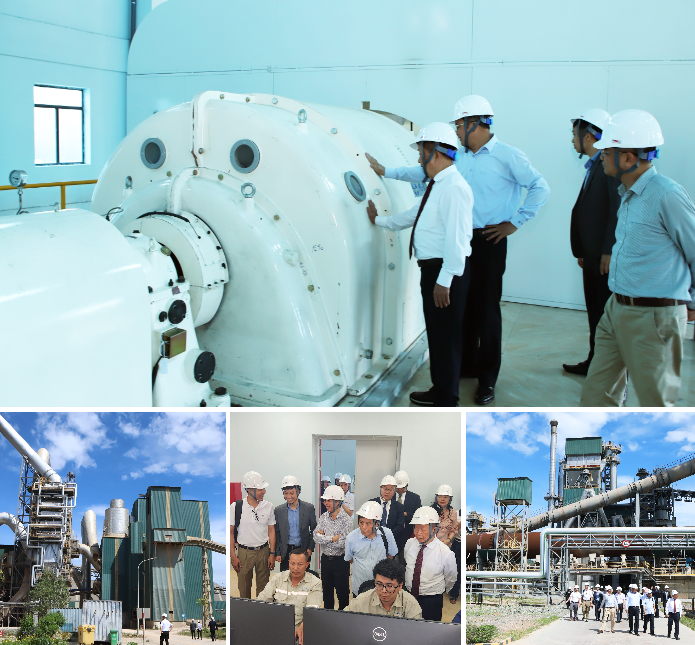Tan Thang Cement Joint Stock Company has inaugurated a WHR power generation system with a capacity of 8,650 kW. This is considered a technological breakthrough aimed at reducing CO₂ emissions, saving energy, and contributing to the sustainable development of the cement industry in Vietnam.
The WHR system was officially put into commercial operation at Tan Thang Cement Plant (Tan Thang commune, Quynh Luu district, Nghe An province) on April 30, 2025. After a period of operation and maintenance, the system has now been integrated into the plant’s production chain.
Mr. Hoang Anh Tuan, General Director of Tan Thang Cement JSC, stated: On the occasion of the 135th birthday of President Ho Chi Minh, in his homeland, we are proud to inaugurate the WHR power generation system at Tan Thang Cement Plant. The system is designed with a capacity of 9,000 kW for a 5,000 tons/day clinker production line. With a gross power output of 8,650 kW and a net output of 8,035 kW, it helps save about one-third of the plant’s total electricity consumption. This is not only a significant technological advancement but also economically beneficial, with a payback period of only around 6 years.
The WHR system captures waste heat from the cement production process to generate electricity.
The system utilizes excess heat from waste gas at the clinker cooler and cyclone preheater tower. This heat source reaches temperatures of 250–400°C and has a high flow rate. The hot gas is routed through heat exchangers to high-pressure boilers, then through turbines to generate electricity.
The WHR system fully utilizes 100% of the waste heat generated during production to generate electricity, reducing CO₂ emissions by about 40,000 tons per year. Dust concentration emitted into the environment has been significantly reduced from 30 mg/Nm³ to just 10 mg/Nm³ – meeting strict environmental standards set by the EU and G7.
By generating electricity from waste heat, Tan Thang Cement Plant will save about 80 billion VND in electricity costs annually.
The system provides a “dual benefit” in energy efficiency: saving 25–30% of the electricity previously purchased from EVN (Vietnam Electricity), reducing annual costs by 78–80 billion VND; and contributing to national energy security while easing the load on the power transmission grid – especially during peak periods.
Commissioning the WHR system marks a significant milestone in the company’s journey toward energy efficiency, environmental protection, resource efficiency, and sustainable development. It also lays a critical foundation for Tan Thang to meet the requirements for receiving the “green cement” label and to begin mass production of environmentally friendly cement products.
Representative of the contractor, Shanghai Conch Kawasaki Engineering Co., Ltd, shared: With our extensive experience in manufacturing equipment lines for cement plants, we have supplied over 300 modern equipment lines globally. In Vietnam, we entered the market in 2002. As for WHR power generation systems, we supplied the first system in Vietnam in 2014 to Chinfon Cement Plant in Hai Phong, which still operates effectively today.
For the WHR project at Tan Thang Cement Plant, beyond the standard equipment lines, we introduced for the first time a new generation of high-pressure steam boilers, which deliver higher electricity generation efficiency than existing products on the market. We also managed to shorten the construction time from 15 months to just 9.5 months—5.5 months ahead of the contract schedule.
Mr. Nguyen Quang Cung, Chairman of the Vietnam Cement Association, emphasized: The WHR power generation system at Tan Thang Cement Plant is the most integrated and efficient among the systems I have observed at various plants nationwide. This success results from proper plant planning, careful consultant and contractor selection, and effective project management. Utilizing WHR for power generation not only helps reduce electricity costs for the company but also greatly contributes to environmental protection and green development.
This project contributes to implementing the National Green Growth Strategy for the 2021–2030 period, with a vision to 2050, and reflects the enterprise’s commitment to Vietnam’s net-zero emissions pledge by 2050 made at COP26. The waste heat recovery technology is expected to become a model for replication across the cement industry—one of Vietnam's most energy-intensive and high-emission sectors.
Duc Do










 Webinar 2: “Financial Support for Energy Efficiency Enterprises – Opportunities and Challenges”
Webinar 2: “Financial Support for Energy Efficiency Enterprises – Opportunities and Challenges”
 Vietnamese enterprises achieve green growth and cut costs through energy efficiency
Vietnamese enterprises achieve green growth and cut costs through energy efficiency
 Capacity Building for Program Implementing Entity
Capacity Building for Program Implementing Entity
 Enhance Energy Efficiency Knowledge for Managers of Cement Industrial Enterprises
Enhance Energy Efficiency Knowledge for Managers of Cement Industrial Enterprises
 Capacity building for participating financial institutions of the VSUEE Project
Capacity building for participating financial institutions of the VSUEE Project
 Capacity building for participating financial institutions in Ho Chi Minh City
Capacity building for participating financial institutions in Ho Chi Minh City
 Strengthening capacity for energy management officers of local government agencies
Strengthening capacity for energy management officers of local government agencies